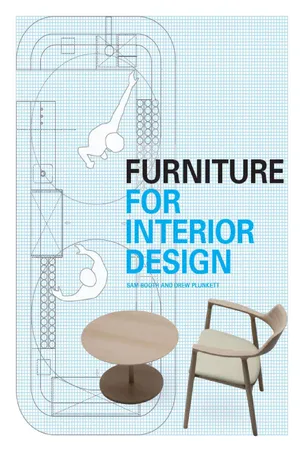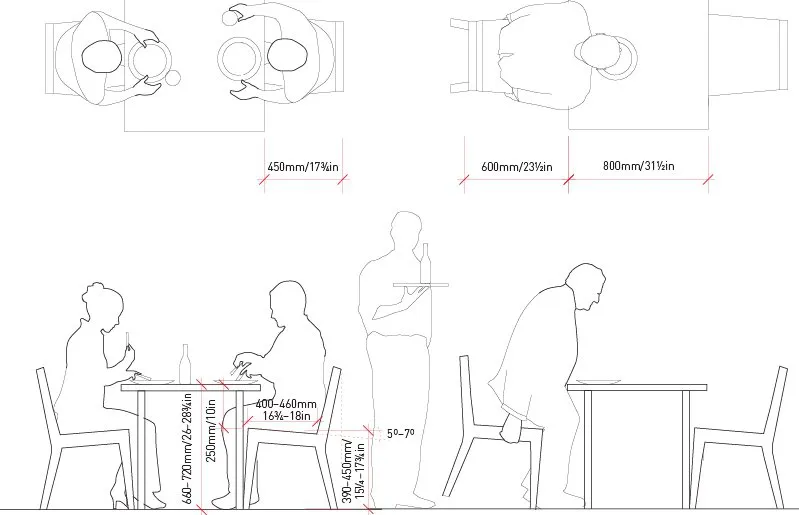![]()
PART 1 CONTENT AND CONTEXT
CONTENT AND CONTEXT
RETAIL
RECEPTION AREAS
WORKSPACES
HOSPITALITY
BARS AND RESTAURANTS
FIXED SEATING AND TABLES
EXHIBITION DESIGN
RESIDENTIAL
SCREENS AND DIVIDERS
STORAGE
MAKING GOOD
Content and context
Whether they are working speculatively or to commission, furniture designers will have in mind a context for each piece they produce and that perception is crucial in decision-making. An office chair is necessarily different from a dining chair, which necessarily differs from an armchair. Designers creating a project-specific piece will have a clear perception of its precise context and functional content but whether they create all, some or none of the furniture used in a particular project, their responsibility is to orchestrate the deployment of individual pieces so that each gives meaning to, and takes significance from its place in, the ensemble. Old pieces may be counterpointed by new. Pieces that are magnificent in isolation may not contribute as much to the whole as more modest options.
Interior designers should not gratuitously design pieces when tried-and-tested, factory-made options exist but, to take advantage of that abundance of choice, they need to have a comprehensive awareness of what is on offer. There will always be a tendency to favour a limited collection of preferred pieces but, since furniture is so crucial to the success of the singular interior it occupies, repetitive selection should be questioned.
The content of an interior will be established by the client or by the client in discussion with the designer, whose responsibility it is to organize space efficiently, as an armature on which to lay the aesthetic veneers of finishes and furniture. Clumsy planning can devalue aesthetic intent. Efficient planning can reduce overheads, improve productivity and establish the aesthetic balance, but there is no simple set of rules that may be applied across the spectrum of interiors. Fine-tuning of basic layout principles will deliver more effective solutions. As long as decisions to adapt are not made gratuitously, adjustments will generally be for the better.
There are a number of books, such as Tutt and Adler’s The New Metric Handbook and Packard’s The Architect’s Handbook, that give dimensional data about furniture sizes and planning layouts. While such books provide valuable reference information, they are most useful for the design of new buildings when the dimensions and plan form may be readily adjusted to suit the prescribed data. With existing interior spaces, however, planning is usually less straightforward. Existing plans are unlikely to accommodate prescribed layouts. It will normally be necessary to decide how much recommended dimensions may be trimmed without prejudicing practicalities. Frequently, if the precise nature of the activity to be accommodated is objectively analysed it may be possible to reduce the recommended allocation for individuals, or to accept that it must be exceeded. The general rules have a factor of safety that can be judiciously pared. Overly rigorous pruning will result in humiliation for the designer.
Designers should take comfort from the knowledge that awkward sites and the problems they pose encourage more ingenious design thinking. It is also important to remember that raw data does not take into consideration how users will experience it in context. The singular beauty of any piece of furniture will go unappreciated if its deployment makes those who use it physically uncomfortable or psychologically uneasy.
Different layouts may encourage or discourage communication and collaboration between workers and determine the nature and degree of interaction in social contexts. Decisions about the desirability of a particular kind of layout can be made from observation of how existing environments function and by questioning those who use them, but ultimately, like all good design, success depends on a designer’s intuition. The most extraordinary conceptual proposal will be worthless if it fails to perform practically. Users may find it difficult to articulate their objections to aesthetic gestures but they are well equipped to criticize practical shortcomings and will seize on the latter to undermine concepts to which they take exception.
The human body seldom conforms to the generalities of anthropometric and ergonomic guidelines.
Standard data is an excellent starting point for planning layouts but the dimensions of an existing interior space will seldom conform to the suggested layouts.
Generic contexts
The unique considerations that relate to the provision of furniture within different categories of interiors and are worth listing. The points cited in the following passage relate primarily to practical considerations but ultimately pieces specified or designed must respond to the character of the organization they serve. All categories of building have been affected by the shifts in habits and behaviour precipitated by digital technologies. So profound have those changes been that it is easy to forget that, while the first widespread manifestations of change emerged in the last decade of the last century, it is only in this century that the influence has accelerated and the impact been fundamentally significant. It is an interesting time to be reconsidering familiar furniture typologies and the interiors they defined.
In workplaces, the consequences of general technological progress have been evident for a couple of centuries. It immediately changed the way in which people worked but, until recently, production remained labour-intensive. Digitally enhanced production methods now need fewer and different kinds of people, and digital communication has created new kinds of jobs and prompted new ways of working. The computer, whether desktop or laptop, allows the person who composes the content of a letter to make it legible. It allows a designer to make ‘drawings’ on the same machine that is used to research the information needed to make them real. Digital information transmission means that underperforming postal services are no longer an excuse for poor communication.
As the capacity of digital technology has become greater, so its physical packaging has become increasingly miniaturized. The realities of mobility now affect the nature of all the pieces of furniture that have evolved to support sedentary activities. Functional zoning has remained recognizably constant and the furniture within zones still broadly fulfils its traditional functional obligations but as the new social media erode social boundaries and discredit formality, physical separation becomes more permeable and furniture layouts are increasingly used to define dedicated areas. The need to express individual or corporate identity looks increasingly to interiors as one of the means to articulate identity, and to furniture as a crucial component in fine-tuning that declaration.
The sections that follow set out the fundamental considerations when specifying or designing furniture for each of the generic categories of interior and the discrete spaces and activities they house.
Different table types and orientations can affect preferred dimensions. While the variation introduced by a single table is modest, the accumulated effect of multiple tables is often significant. Projections or indentations on a plan can cause localized problems.
Case study Better planning solves problems
Research, and personal experience, suggest that efficient planning is not enough to make a good interior. Users have to enjoy being in it, and for this they will be prepared to accept a degree of functional compromise. This principle applies across the spectrum of interior environments but is perhaps most likely to be overlooked in workplaces, where pleasure has, understandably, been seen as of secondary importance. But, since work is a primary source of self-esteem, the right choice of furniture will have a benign effect. An intelligent response to the existing elements of an interior is necessary to maximize the effectiveness of furniture. In the example illustrated the client had brought furniture from his old to his new office and, finding the working environment unsatisfactory, had called for professional advice.
In the office show...




